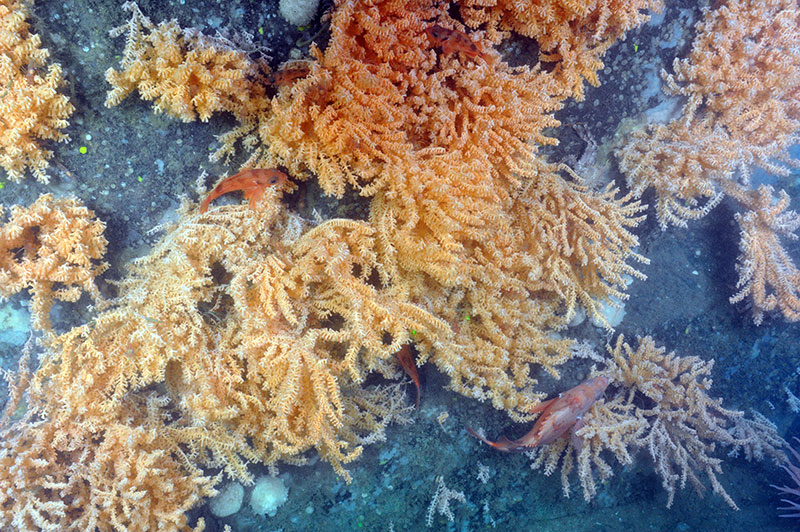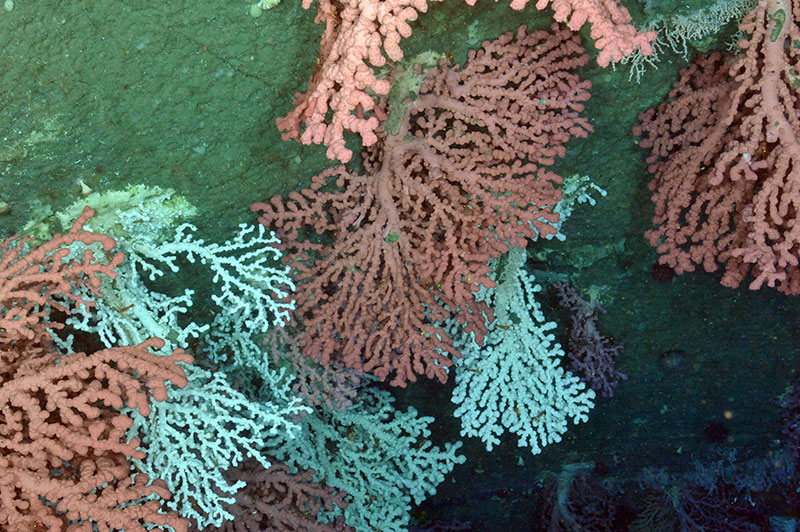
by Dr. Anna Metaxas, Professor, Dalhousie University

Surveys in Jordan Basin, northern Gulf of Maine, revealed high densities of the red tree coral, Primnoa resedaeformis. Image courtesy of 2014 Bigelow-ROPOS US-Canada Gulf of Maine Collaboration. Download larger version (jpg, 6.2 MB).
The Northwest Atlantic continental shelf and slope are significant both for their biological assemblages, which include important fisheries species, and for their other natural resources, such as oil and gas. To meet its international obligations, the Canadian government has committed to establish a national network of marine orotected areas (MPAs) to protect 10 percent of marine and coastal areas by 2020. The Department of Fisheries and Oceans (DFO) currently leads the design and implementation of such a network.
An effective and relevant design of a network of MPAs (MPAn) must be based on sound knowledge of species distributions and hotspots of diversity and an understanding of mechanisms that regulate distributions and key seabed functions. Unfortunately, we largely lack data on faunal distribution, abundance, diversity, and function for deep-sea regions of the Northwest Atlantic. Our limited ability to sample such large, remote areas creates a critical need to develop predictive capacity based on realistic logistics. Nonetheless, predictive models require validation with empirical data.

Large colonies of bubblegum corals were observed on the walls of Corsair Canyon. Image courtesy of 2014 Bigelow-ROPOS US-Canada Gulf of Maine Collaboration. Download larger version (jpg, 5.4 MB).
Over the last 15 years, we have generated an extensive dataset on the biological communities and their environment, along with predictive models for the occurrence of deepwater corals, in canyons and the continental slope off the northeastern United States and Atlantic Canada, as well as in Gulf of Maine. In Canada, we have worked closely with DFO to assist with data collection for the design of an offshore MPAn. A research cruise in 2001 with the remotely operated vehicle ROPOS collected information that assisted with the fishery closure of the Northeast Channel Coral Conservation Area in 2002. Most recently, we assessed the effectiveness and current boundaries of that closure. In June 2014, a research cruise conducted by Dalhousie University and NOAA, in collaboration with DFO, revealed significant aggregations of deepwater corals within Canadian waters in Corsair Canyon for the first time and in Jordan Basin. These coral communities qualify for protection under DFO’s Policy for Managing the Impact of Fishing on Sensitive Benthic Areas (SBAs). In 2016, the Jordan Basin Conservation Area and the Corsair and Georges Canyons Conservation Area were established as SBAs, prohibiting, for the most part, bottom fishing within their boundaries.
Successful protection requires knowledge or accurate prediction of population sizes, distributions, and connectivity across relevant scales, which ignores international borders. Since 2011, we have worked to coordinate our research between Canadian and U.S. colleagues, allowing us to appropriately treat the Gulf of Maine and the adjacent continental slope as an entire ecoregion. The NOAA 2016 Report to Congress on Deep-Sea Coral Research highlighted the first collaboration. We are now setting off for the second cruise of this joint collaboration, once again visiting deepwater coral ecosystems on either side of The Hague line.